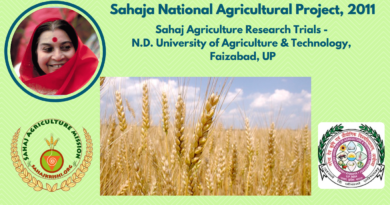Sahaj Agriculture Research – National Research Centre on Camel, Bikaner
Sahaj Agriculture Research – National Research Centre on Camel, Bikaner
Report of findings of a collaborative experiment on studying the effect of vibrated seed and water by Sahaj Yoga Treatment on the yield of green and dry fodder and seed production in Rabi Oats.
An experiment was conducted on Oats Fodder Crop grown at NRC on Camel, Bikaner during 2015 Rabi Season. The treatment consisted of:
- A-Sowing of vibrated oat seeds irrigated with vibrated water.
- B-Sowing of non-vibrated seeds irrigated with vibrated water.
- C-Sowing of vibrated seeds irrigated with non-vibrated water.
- D-Sowing of non-vibrated seeds irrigated with non-vibrated water.
Each treatment plot had four main replications from 1 to 4 of which 1, 2 and 4 replications were used for studying the fodder production parameters and 3rd replication of each treatment plot was kept till maturity of oats crop and seed production and dry fodder production was recorded for each treatment plot. The experiment for fodder production continued till second cut of fodder was obtained i.e. from 103 to 111 days of sowing and first cut was taken at 60 to 68 days after sowing. The green fodder yield (quintals) for 1st and 2nd cut of oats fodder for A to D treatments was 1556 & 445, 1598 & 480, 1337 & 419 and 1320 & 339, respectively. The dry matter yield(quintals) for the first and second cut for respective groups were 218.77& 78.38, 233.29 &77.21, 179.66 & 63.72 and 184.72 & 48.33 indicating that the total green and dry fodder yield was highest in treatment B group followed by A,C and D. The seed production (Kg) was highest for treatment D (36.90) followed by C (33.20), A (31.10) and B (30.20) and dry fodder yield (kg) was highest for D (90) followed by 60 kg obtained in both A and B treatments and 50 kg obtained in C.
Table . Effect of Vibrated seed and water on the green, dry fodder yield and seed production in Rabi oats
| Treatment | Green Yield (Kg) | DM( %) | Dry yield(Kg) | Seed Yield(kg) A3 TO D3 | Dry fodder Yield(kg) A3 TO D3 | |||
| I Cut 20-2to 2.3.16(60-68 d) | II Cut 5.4 to 11.4.16(103-111 d) | I Cut | II Cut | I Cut | II Cut | 31.100 | 60.000 | |
| A1 | 360 | 195 | 17.94 | 21.33 | 64.58 | 41.59 | ||
| A2 | 562 | 150 | 14.80 | 16.82 | 83.18 | 25.23 | ||
| A4 | 634 | 100 | 11.20 | 11.56 | 71.01 | 11.56 | ||
| TOTAL A | 1556 | 445 | 218.77 | 78.38 | ||||
| B1 | 340 | 185 | 14.03 | 19.61 | 47.7 | 36.28 | 30.200 | 60.000 |
| B2 | 619 | 165 | 17.13 | 13.95 | 106.03 | 23.02 | ||
| B4 | 639 | 130 | 12.45 | 13.78 | 79.56 | 17.91 | ||
| TOTAL B | 1598 | 480 | 233.29 | 77.21 | ||||
| C1 | 365 | 169 | 14.02 | 17.60 | 51.17 | 29.74 | 33.200 | 50.000 |
| C2 | 412 | 150 | 13.79 | 13.24 | 56.81 | 19.86 | ||
| C4 | 560 | 100 | 12.80 | 14.12 | 71.68 | 14.12 | ||
| TOTAL C | 1337 | 419 | 179.66 | 63.72 | ||||
| D1 | 470 | 134 | 12.66 | 14.29 | 59.5 | 19.15 | 36.900 | 90.000 |
| D2 | 350 | 100 | 16.62 | 14.10 | 58.17 | 14.1 | ||
| D4 | 500 | 105 | 13.41 | 14.36 | 67.05 | 15.08 | ||
| TOTAL D | 1320 | 339 | 184.72 | 48.33 |
Source: Dr. N. V Patil, Dated 22/11/2016
Results at glance:
| No | NRC | Crop Tested | Differences by means (% increase over control) | Statistical Inference | Remarks |
| 10 | CIAH, Bikaner, Rajasthan | Oats | Green fodder kg/ha Vibrated- 1st cutting: 1556 2nd cutting: 445 Non-vibrated- 1st cutting : 1320 2 nd cutting: 339 | 20.61% increase green fodder production over control. | Details Enclosed |




